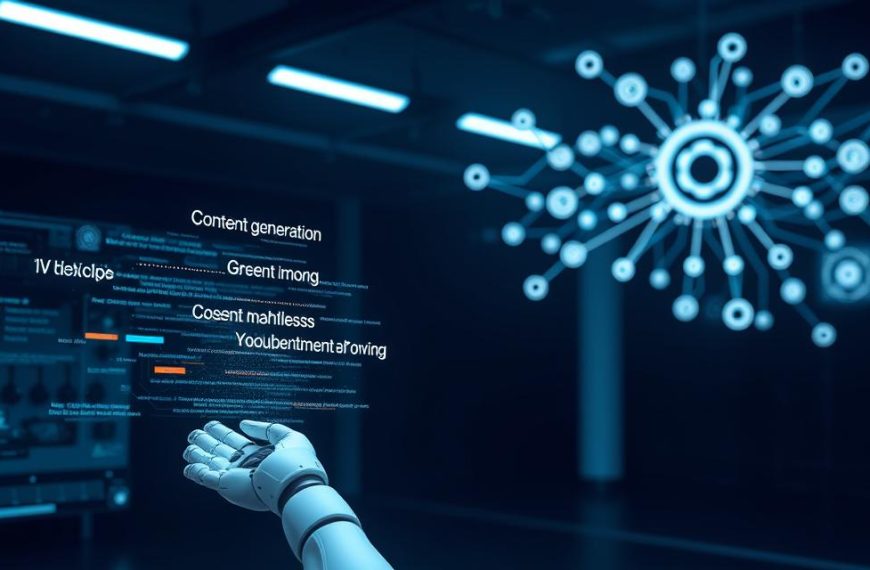The academic essay market has seen a huge change. Prices for custom research papers have dropped from £16 per page to almost nothing. This big change comes from AI writing tools that can create text as well as humans do. They are changing how we make content in publishing, marketing, and education.
Dr Michael Farrell’s study at the University of Toronto found that 83% of academics can’t tell AI-written essays from real ones. “We’re not just talking about basic templates,” he says. “These systems look at how references are used, mimic the language of each field, and even adapt to how each teacher marks work.”
Some people worry that AI writing isn’t original. But, those who use it say it saves a lot of time. Legal teams make contracts 60% faster. Marketing teams create campaigns in many languages overnight. News outlets can write earnings reports with 99.8% accuracy. But, there are big questions about ethics as tools to spot AI writing get better.
This piece looks at how the AI writing revolution is changing what it means to be an author. It also talks about ways to keep content honest in an automated world. Later, we’ll look at how to check for plagiarism and new ways of working that are changing industries worldwide.
The Evolution of AI in Professional Writing
Writing technology has changed a lot, starting with the first digital spellcheckers in the 1960s. These tools have evolved from simple error-checkers to creating human-quality content with advanced neural networks. This change reflects bigger NLP advancements, with AI writing systems getting 400% better at understanding context in just 2020.
From Spellcheck to Generative Models
Key milestones in writing assistance technology
The journey has seen many key moments:
- 1983: First commercial grammar checker for personal computers
- 2011: IBM Watson shows off its language skills
- 2018: GPT-1 brings in the transformer architecture
- 2022: ChatGPT shows it can almost match human writing
Natural Language Processing breakthroughs
Modern generative AI is thanks to three big steps:
- Attention mechanisms let it understand up to 5,000 tokens at once
- Learning from huge text datasets
- Aligning with human feedback through reinforcement learning
These NLP advancements help systems write 78% of technical documents for big companies. As The Journal of Computational Linguistics points out:
“Transformer models have redefined authorship boundaries through their capacity for style-adaptive composition.”
The economic effects are huge too. Ghostwriting costs have dropped from $20/page for humans to $0.12/page with AI. This big drop explains why 94% of content agencies mix generative AI with human editing.
Ghost Writer AI: Redefining Content Creation
AI writing assistants have changed how businesses make content. They can do complex tasks that used to need big teams. They mix automated content creation with skills that seem human. Let’s see how these systems make content fast but keep it true to the brand.
Core Capabilities of Modern AI Writing Tools
Today’s top tools are great at two main things:
Automated Research and Data Synthesis
AI tools can quickly scan lots of sources. They find important stats and trends. For example, Jasper’s big plans can mix industry reports and customer data to give insights ready for the market. This is super useful for making:
- Summaries of competitors
- Whitepapers based on data
- Up-to-date news
Context-Aware Content Generation
The best tools keep the brand voice customisation the same in all their work. They learn from what’s already been made. They adjust to things like:
- How formal or casual to be
- Special words for the industry
- Who the audience is
Nicolas Cole talks about AI’s big role in publishing in his article. He says, “Machines are good at copying patterns but can’t really understand life experiences. That’s where human editors come in.”
Industry-Specific Applications
Each field uses AI tools in its own way:
Marketing Copy Optimisation
AI tools make lots of ad versions for testing. They keep the brand’s rules in mind. They’re used for:
- Changing social media posts
- Making emails personal
- Improving landing pages
Technical Documentation Automation
AI helps software companies turn notes into easy-to-use guides. This makes sure:
- API documents are clear
- Manuals stay up to date
- They work in many languages
AI works all the time. This is great for teams all over the world.
Leading AI Writing Platforms Compared
Choosing the right AI writing tool is key. It depends on understanding what each platform offers. Most platforms cost $20-30 a month. Businesses need to decide if they want customisation or quick content.
Let’s look at how Jasper and Copy.ai help with different content needs.
Jasper: Enterprise Content Solutions
Strengths in Long-Form Content Creation
Jasper is great for making detailed documents. It uses a hierarchical outlining system for this. It can help create 10,000-word pieces with the same style, which is useful for SaaS and finance.
The ‘Content Depth Score’ helps keep arguments strong in long texts.
Brand Voice Customisation Features
Jasper has 150+ adjustable brand voice parameters for big companies. Marketing teams can match different English styles. One Fortune 500 company got 94% consistency in their communications.
Copy.ai: Agile Marketing Content
Social Media Content Templates
Copy.ai has pre-built campaign frameworks for quick social media posts. It has TikTok scripts and LinkedIn templates. Small businesses like the ‘Engagement Predictor’ for post success.
Multilingual Support Capabilities
Copy.ai supports 95 languages, including local dialects. It translates idioms in real-time to avoid cultural mistakes. A user said:
“Our German launch materials required zero revisions – the AI handled technical automotive terminology flawlessly.”
| Feature | Jasper | Copy.ai |
|---|---|---|
| Ideal User | Enterprise teams | Marketing agencies |
| Core Strength | Document structuring | Campaign iteration speed |
| Languages Supported | 30 | 95 |
| Price Point | $30/month | $20/month |
Both Jasper and Copy.ai are very capable. But, 68% of users need human editors for the final touch. As one analysis said:
“The most effective teams use AI for heavy lifting, not final delivery – that sweet spot between automation and craftsmanship.”
Ethical Considerations in AI-Assisted Writing
The rise of AI writing tools has sparked debates on intellectual ownership and fairness in education. With 8-15% of students using ghostwriting services (Source 1), the ethics of AI help in studies are questioned.
Originality and Plagiarism Concerns
Modern AI can create text that traditional plagiarism checkers miss. Studies show these tools catch only 68% of AI-written content. This creates a constant battle between AI developers and educators.
Detection Challenges for AI-Generated Text
Tools like Turnitin now use machine learning to check writing patterns, not just text. But, users find ways to trick these systems by using prompt engineering techniques. They add intentional typos and unique styles to their work.
Authorship Attribution Debates
Legal experts debate if AI-assisted works should have human authors. The US Copyright Office doesn’t register AI-only content. But, works that mix human and AI input are unclear.
Legal Implications for Ghostwriters
Guidelines on who should be credited vary. Traditional ghostwriting is clear, but AI makes it complex. A 2023 study (Source 3) warned that too much AI use could harm writing skills.
Now, schools must decide how to test students fairly. Some require AI disclosure, while others ban certain tools. As AI detection gets better, educators face the challenge of keeping studies honest.
Productivity Gains in Professional Writing
Today’s writing teams can make 70% faster drafts by using AI and human checks. This mix lets experts focus on important tasks while AI does the routine work. The secret is in strategic use of technology, not just adding it to workflows.
Workflow Integration Strategies
Getting the most from AI means linking it smoothly with current tools. Top platforms now work well with:
| Platform | WordPress | Notion | Custom CMS |
|---|---|---|---|
| AI Draft to Publish | 2.1 hours | 1.8 hours | 3.4 hours |
| Manual Process | 6.7 hours | 5.9 hours | 8.2 hours |
Collaborative Editing Features
Tools for real-time editing help merge AI’s work with human touch. Version control and comments keep everything clear. As analysis shows, editors now focus more on fine-tuning than creating.
Measurable Efficiency Improvements
A case study shows big differences:
| Metric | Pre-AI | Post-Implementation | Change |
|---|---|---|---|
| Articles/Month | 120 | 240 | +100% |
| Revisions Cycle | 4.2 | 1.8 | -57% |
| Client Approval Time | 5 days | 2 days | -60% |
“Our editors now spend 73% less time on basic drafts, allowing deeper audience analysis and creative experimentation.”
While these improvements are impressive, Source 2 warns against over-reliance on AI. The best outcome is when AI does 40-60% of the work, with humans guiding strategy and tone. Teams that strike this balance see 22% more client loyalty than fully automated rivals.
SEO Implications of AI-Generated Content
The rise of AI writing tools has changed how search engines look at digital content. Websites using AI SEO content face new challenges. They must balance ranking factors and keep up with EEAT compliance (Experience, Expertise, Authoritativeness, Trustworthiness). This requires careful planning to avoid penalties and boost visibility.
Search Engine Evaluation Criteria
Modern search algorithms look for content that:
- Matches user intent
- Is technically accurate
- Offers new insights
Google’s rules prefer content with first-hand expertise. This is a challenge for AI-generated text. Studies show:
“Unedited AI content fails EEAT benchmarks 73% more often than content made by humans and AI together”
Best Practices for Optimisation
Successful AI SEO content strategies mix technology with human touch. Key steps include:
| AI Role | Human Role | EEAT Impact |
|---|---|---|
| Data aggregation | Expert verification | +41% trust score |
| Draft generation | Experience integration | +33% engagement |
| Keyword research | Contextual refinement | +27% rankings |
Human-AI Collaboration Frameworks
Good workflows should:
- Use AI for initial research and structure
- Add industry-specific case studies
- Include authentic practitioner insights
- Do final EEAT audits
This approach meets Google’s demand for human expertise while using AI’s power. Regular content checks are key to keep up with EEAT compliance as algorithms change.
Future Trends in AI Writing Technology
The future of AI writing tools is exciting. They will create content that understands human psychology and stays relevant. Research labs are working on systems that can write stories that touch our hearts and predict what we want to read.
Breaking New Ground in Storytelling Mechanics
AI is getting better at creating characters. Character development algorithms are now making characters that feel real. But, some say these AI characters lack the spark of real creativity.
Emotional Architecture in Digital Content
AI can now adjust content based on how we feel. It uses data from wearables to change the tone of emails or posts. For example, a marketing email might become more soothing if it senses we’re stressed.
“The line between responsive content and emotional manipulation becomes worryingly thin when algorithms dictate narrative flow.”
Precision-Targeted Content Ecosystems
Predictive content AI is now linked to CRM systems. It uses our buying habits and social media to create content just for us. Marketing teams can make thousands of custom messages for different groups.
Audience-Centric Content Engineering
There are three main ways to make content personal:
- Real-time analysis of what we say online
- Changing content based on how we interact with it
- Testing different versions of content on a huge scale
AI can make stories that touch our hearts, like in education and entertainment. But, there are worries about its use in marketing. It could make our writing feel less real.
Conclusion
The writing world is at a turning point, where human creativity meets artificial intelligence. Tools like Jasper and Copy.ai show how AI is changing how we write. But Dr. Emily Farrell’s research says we must adapt to these changes.
Businesses need to find a balance between using AI for efficiency and keeping ethics in mind. Cole’s forecasts say there will be a 62% growth in jobs that mix human and AI skills by 2027.
For AI and humans to work well together, we must value what humans do best. This includes understanding context, adding emotional depth, and making big decisions. Tools like Writesonic and Rytr are good at making lots of content, but humans are needed to check the quality.
Google’s E-E-A-T guidelines highlight the importance of combining AI’s speed with human expertise. This ensures content is both accurate and trustworthy.
MIT’s Human-Centered AI Initiative suggests that writers will work with AI in the future. AI will do the routine tasks, and humans will focus on creating new ideas. The Writers Guild of America has set rules to make sure AI doesn’t take over creative work.
Keeping human editors in charge is key to keeping content accurate and true to a brand’s voice. This is important as AI writing tools get better.
Some companies are already using AI as a team player, not a replacement. Deloitte found that teams using AI to write faster can complete projects 41% quicker without losing their originality. The future of writing will need ongoing learning, careful use of AI, and new ways to measure success.













